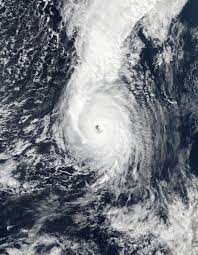Hurricane Ophelia Strikes North Carolina’s Coast, Unleashing Torrential Rain and High Winds

In a dramatic turn of events, Hurricane Ophelia made its presence felt on the North Carolina coastline early Saturday, unleashing its fury with relentless winds and perilous surges of water, according to the U.S. National Hurricane Center.
Ophelia’s Landfall and Intensity
The hurricane’s center officially struck land at approximately 6:15 a.m., near Emerald Isle, North Carolina. With maximum sustained winds reaching a formidable 70 mph, this marked a critical moment for the region. The impact zone was situated roughly 25 miles northwest of Cape Lookout.
Imminent Threat of Flooding
As Ophelia stormed ashore, it carried with it the ominous threat of life-threatening flooding across parts of eastern North Carolina and southeastern Virginia. However, there was a glimmer of hope as the hurricane center projected a weakening trend for the system after landfall.
Ophelia’s Path and Weekend Outlook
The trajectory of Hurricane Ophelia was closely monitored, with predictions indicating a northward turn on Saturday, followed by a northeastward shift on Sunday. As a result, the weekend loomed with the promise of gusty conditions and substantial rainfall. Anticipated rainfall amounts ranged up to 7 inches in certain parts of North Carolina and Virginia, with 2 to 4 inches expected throughout the rest of the mid-Atlantic region by the end of Sunday.
Surge Warnings and Watches
A storm surge warning, signifying the impending danger of rising waters infiltrating coastal areas, was issued from Bogue Inlet, North Carolina, extending to Chincoteague, Virginia. Forecasts predicted surges ranging between 4 and 6 feet in specific regions, raising concerns for residents and authorities alike. Additionally, a tropical storm warning encompassed the stretch from Cape Fear, North Carolina, to Fenwick Island, Delaware. North Carolina was also placed under a hurricane watch for the area north of Surf City to Ocracoke Inlet.
State of Emergency and Preparations
Reacting swiftly to the impending crisis, the governors of North Carolina, Virginia, and Maryland declared a state of emergency on Friday. This proactive measure was taken as some schools preemptively closed and numerous weekend events faced cancellation. North Carolina Governor Roy Cooper emphasized the importance of readiness, especially for farmers, first responders, and utility crews, in light of the unpredictable path of the storm.
Service Suspensions and Community Resilience
In response to the approaching storm, the North Carolina Ferry System suspended service on all routes until conditions improved. Similarly, Virginia Governor Glenn Youngkin’s executive order aimed to facilitate response and recovery efforts, urging residents to prepare emergency kits and stay updated on weather forecasts. Maryland Governor Wes Moore also issued a statement, anticipating a prolonged period of strong winds, heavy rainfall, and elevated tides.
Local Impacts
The effects of Hurricane Ophelia rippled across communities, with businesses and services adjusting to ensure safety. In Annapolis, Maryland’s capital, water taxi services were temporarily halted, prioritizing passenger safety and vessel protection. In Washington, D.C., the Nationals baseball team postponed its Saturday game to Sunday, considering the safety of players and spectators.
Understanding the Hurricane Season
National Hurricane Center Director Michael Brennan noted that it’s not uncommon for one or two tropical storms, or even hurricanes, to develop off the East Coast each year. As we currently find ourselves at the peak of hurricane season, the possibility of storm formation remains a constant concern. Additionally, climate change poses a significant factor, potentially leading to an increase in hurricanes venturing into mid-latitude regions. This could make storms like Hurricane Lee, which occurred earlier this month, more frequent and severe.
The Future of Hurricane Activity
Researchers studying the impact of climate change have generated simulations that illustrate the evolving nature of tropical cyclone tracks. These simulations reveal that hurricanes may track closer to densely populated coastal areas, including Boston, New York, and Virginia, becoming more prevalent along the Southeast coast. This underlines the urgency of addressing climate change and its far-reaching consequences.
Community Preparedness
In a display of resilience and caution, Nancy Shoemaker and her husband, Bob, collected sandbags from a waterside park in downtown Annapolis. Their decision was driven by past experiences when a water surge during a storm last October swept away sandbags they had placed in their yard. As Nancy Shoemaker aptly put it, “We’re hoping it won’t be that way this time. If we have a lot of wind and a lot of surge, it can look like the ocean out there, so that’s a problem.”
As Hurricane Ophelia continues its journey, communities along the East Coast are reminded of the importance of preparedness, unity, and vigilance in the face of nature’s formidable forces





